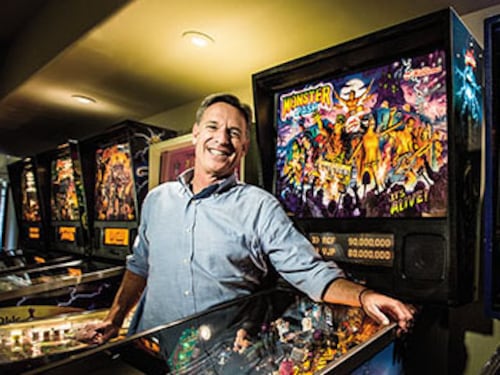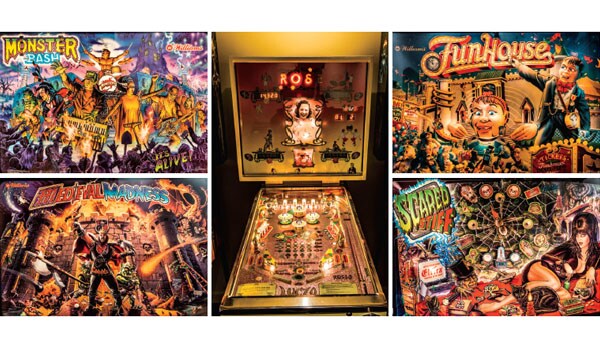The Pinball Wizard: Seagate Technologies' CEO Steve Luczo
With his collection of retro machines, Seagate Technologies' CEO Steve Luczo is preserving the analogue artistry that he first flipped for as a teenager


I ’m trying to preserve culture that people aren’t paying attention to,” says Steve Luczo as he furiously paddles silver balls at alien spaceships. He’s in multiball mode on ‘Attack from Mars’, one of the 64 pinball machines in his prized collection. It ranks as a favourite, earning a spot in the basement of his Silicon Valley home instead of in a warehouse north of San Francisco.
Luczo doesn’t play pinball as much as he used to. He has other balls in the air as the second-time CEO of hard-drive maker Seagate Technologies and a member of the search committee that recently anointed Satya Nadella as Microsoft’s new leader. The 57-year-old also has three young children, who have each set up a stool in front of a glass-topped machine, filling the basement with the noise and chaos of an arcade.
His wife, Agatha, a model whose name is tattooed on his ring fnger, watches, bemused.
“It’s important to preserve history so that I can hand it down to them,” says Luczo, who also collects 2,000-year-old Roman coins and first editions of science texts and classic children’s books. His pinball collection includes machines from the late 1950s through the early 2000s. For sheer nostalgia’s sake, he has the classic games he played as a teen in the 1970s. ‘Quick Draw’ and ‘Duotone’ have simple themes, with bull’s-eyes and dinging posts to hit to score points. But his favourites are the more technologically advanced machines from the post-1985 era that have multi-layered ramps, “better flipper action” and various interactive features. ‘FunHouse’, for instance, has an animatronic head named Randy, whose eyes creepily follow the pinball as he heckles the player. There’s also ‘Monster Bash’, in which Dracula, Frankenstein and horror heavies are recruited with successful scoring to perform in a band. And in Medieval Madness, a damsel in distress is voiced by a young Tina Fey, who asks, “What am I, chopped liver?” when her target is missed.
Wait, Tina Fey? Chicago, where Luczo is from, was once the epicentre of the pinball industry, home to the three big manufacturers then in operation: Williams, Bally and Gottlieb. When Williams released ‘Medieval Madness’ in 1997, it asked the legendary local comedy troupe Second City to write the script that accompanied the castle-storming game and give voice to the characters. “Tina Fey probably doesn’t even remember doing it,” says Luczo.
As for his pinball tastes, Luczo isn’t interested in collecting rare games. Instead, he wants pinball’s most popular machines for a collection that reflects the game’s heyday, before it was displaced by computer and videogames. “In the ’70s, pinball was everywhere, in all the bars and arcades,” he says. “Everyone played pinball. Pool was for the bad boys.”
Not that pinball didn’t have a “bad boy” phase of its own. In the 1940s, the machines were illegal in most of the United States because it was considered a form of gambling. In popular culture, pinball stood in as a symbol of rebellion—leather-jacket-wearing, motorcycle-riding Fonzie in Happy Days was a pinball champ. But by the mid-’70s, most American cities had relaxed their bans.
“In my first year of college at the University of Illinois, every dorm and every bar had a pinball machine,” Luczo recalls.
When he transferred to Stanford for the rest of his undergraduate study and business school, he discovered pinball machines were less prevalent on the West Coast, perhaps because people could actually spend most of the year outside. He and Stanford classmate Joe Sweeney bonded over their shared love of the game. Later, after they worked at Salomon Brothers together, Sweeney got Luczo started as a collector, giving him a ‘Dracula’ machine for his 40th birthday. “I began buying machines regularly after that,” he says. The majority of the machines in the collection cost $5,000 to $10,000 each, but he will sometimes buy two of the same game so he can leave one in the box in mint condition.
 Distant Replay: Luczo’s collection includes machines from his youth as well as the late ’80s and ’90s, including ‘Medieval Madness’ featuring the voice of Tina Fey
Distant Replay: Luczo’s collection includes machines from his youth as well as the late ’80s and ’90s, including ‘Medieval Madness’ featuring the voice of Tina Fey
Sweeney is also responsible for the one true rarity in his collection. When Luczo and Agatha married in 2009, Sweeney’s wedding present was a custom pinball machine named ‘Rose’ in honour of Luczo’s mother, who had died the year before. Previously a Kiss rock band machine, it was redone in pink and yellow with photos of Rose, including one from her wedding day, on the backboard and special “wedding” and “kid” bonuses on the field of play for scoring. The machine’s soundtrack is all Frank Sinatra, her favourite. It’s the only one of the machines that’s not free play, requiring specially designed Rose coins. “It was the most touching wedding gift,” he says. “And it’s my daughter Rosalia’s favourite.”
Luczo sees pinball machines as a comely combination of art and technology, and a sort of metaphor for something even bigger. “Electromagnetic device meets street art,” he says. “It’s a little game of life. There are no written rules. You have to interact with it to make it work. Sometimes unfair things will happen. It’ll say you tilted when you didn’t. Other times, you get a free ball for no reason. Like life, you have a certain amount of control, but it’s not absolute.”
Luczo likes the idea of preserving a slice of this analogue technology as we move into an all-digital world. “Pinball machines capture a more innocent and simple time. No war. Drugs were not that readily available or powerful. The country was smaller,” he says. “Everything wasn’t so fast.”
The irony, of course, is that his company’s processors have helped accelerate the world’s pace and fed the desire for more realistic digital games, which hastened the extinction of devices like pinball machines.
He once almost let his nostalgia get the better of him. In the late ’90s, Luczo nearly added a pinball company to his collection. The industry was “running out of steam”, he remembers. In the blood sport between pinball and PlayStation competition, the latter was clearly winning. Luczo and Sweeney considered buying one of the last big manufacturers, Williams Pinball, from its parent company, WMS, which had shifted into the more popular (and profitable) business of making slot machines for casinos.
“We flew to Chicago and spent a few days with the developers and management, learning about the business, and made a bid,” Luczo says. WMS wasn’t interested, though, because it needed to hold on to the pinball division’s intellectual property and development team for its growing casino gaming business. Two years later, when WMS shut down the pinball unit, it left just one new pinball manufacturer standing: Stern Pinball, also in Chicago. The company takes pop culture memes—Pirates of the Caribbean, The Simpsons—and creates games around them. “Stern has done an incredible job,” Luczo says. But he still prefers the made-up themes of the game’s past.
“Even though it’s goofy, they capture a magical period,” Luczo says. “What will people think of these things in 100 years?”
First Published: Jun 06, 2014, 06:43
Subscribe Now(This story appears in the Jan 08, 2010 issue of Forbes India. To visit our Archives, Click here.)